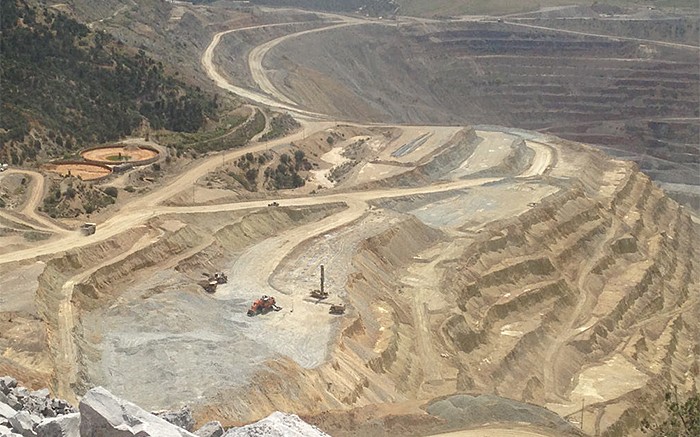VANCOUVER — Management at Capstone Mining (TSX: CS) acknowledged some of the questions surrounding its balance sheet during a mid-February conference call scheduled to discuss its financial performance last year. The spectre of longer-term low copper prices has haunted red metal producers over the past six months, and though the company has reduced operating and capital costs it may still need to negotiate relief on debt covenants in early 2016.
The story isn’t particularly uncommon given the recent plunge in copper markets. Capstone negotiated its largest acquisition — the US$650-million purchase of the Pinto Valley copper mine in Arizona from BHP Billiton (NYSE: BHP; LON: BLT) — back in April 2013, when copper was sitting at around US$3.35 per lb. Since then the red metal has dropped over 40% to US$2.07 per lb. at the time of writing.
In early 2014 the company announced an updated mine plan it labels Pinto Valley 2 (PV2), which extends operations through 2026 based on proven-and-probable reserves of 232 million tonnes at 0.33% copper. Total capital costs for the new plan were pegged at US$188 million, which would lead to average annual production for the first five years of 128 million lbs. of copper contained in concentrate and 6.6 million lbs. of copper cathode.
Capstone followed up in early 2016 with its Pinto Valley 3 (PV3) plan, which extends the mine life by 13 years to 2039 and increases throughput by 8% without “any major capital investment.” Annual production will average 55,700 tonnes of copper from 474 million tonnes of proven-and-probable reserves grading 0.31% copper.
The company reported production of 92,600 tonnes of copper in 2015 at cash costs of around $2 per lb. Operating cash flow before changes in working capital for the year was US$60 million, or 16¢ per share, with a net loss of US$251.5 million. Capstone’s numbers are based on a realized copper price of US$2.35 per lb.
“Our key objectives this year are to ensure liquidity and covenant compliance, as well as optimize our existing operations,” commented president and CEO Darren Pylot during a conference call. “We have invested significant capital over the past couple of years to implement the PV2 mine plan, and prepare for the high-grade Minto North ore we’ll receive this year. We’re now setup for reduced operating costs and significantly lower capital expenditures.”
Capstone estimates its 2016 expenditures at US$40 million for sustaining capital, US$2.3 million for PV3 development work and US$37.7 million for capitalized stripping at Pinto Valley and its Minto mine in the Yukon. The company has tentatively earmarked around US$8 million for brownfield and greenfield exploration, but notes that spending will be “discretionary.”
Capstone’s 2016 production guidance calls for 108,000 tonnes of copper, with cash costs ranging from US$1.45 to US$1.55 per lb. net of by-product credits
The company’s dwindling cash flows at current copper prices have led to concerns over a series of debt convenants due in the next three years. The major financial over hang comes in 2019, when Capstone is on the hook for over US$300 million under a secured-debt facility. Pylot acknowledged it was possible that current copper prices could require the company to negotiate covenant relief in the next few months, and noted that discussions with lenders are “well down the track.”
“In addition to our cost reduction actions and continuing cost improvements at site, we have levers we can pull, if required, to maintain covenant compliance and strengthen the balance sheet,” Pylot elaborated.
“These actions could provide significant relief in terms of debt, and allow us to remain in compliance, even if commodity prices deteriorate further and remain at depressed levels for an extended period. We are essentially setup operationally this year to handle lower copper prices through lower capital and operating programs, combined with increased grades and throughput,” he added.
On top of negotiating covenant relief, Capstone estimates it has around US$50 million of finished copper concentrate available that it could use to secure short-term, higher-cost financing. Perhaps more interestingly, the company inferred it could look at “monetization of assets” or “partnerships” if copper prices continue to struggle.
Capstone reported cash and equivalents of US$101.6 million to end the year, along with net debt of US$250 million.
BMO Capital Markets analyst Sasha Bukacheva believes the company should be able to handle its balance sheet in 2016, but remains “concerned about the prospects of a refinancing gap of US$256 million in 2019, when the credit revolver matures.” BMO Research forecasts Capstone’s free cash flow generation at US$17 million in 2016, negative US$15M in 2017, and negative US$30M in 2018. Bukacheva maintains a “market perform” rating on the company and a 50¢ per share price target.
Capstone has traded within a 52-week window of 27¢ and $1.71, and closed at 38¢ per share at the time of writing. The company maintains 387 million shares outstanding for a $152 million press-time market capitalization.
“When we talk about partnerships, we’ve received in-bounds on other companies wanting to potentially buy assets together,” Pylot concluded. “Or it could be something along the lines of what Freeport-McMoran (NYSE: FCX) did at Morenci, where we sell a portion of an existing asset. That was good to see. Obviously industry players have a much different value on the price of copper long-term than the equity markets. But any straight asset sales are at the bottom of our priority list.”


Be the first to comment on "Capstone outlines strategy to combat low copper price"